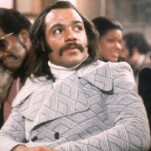My Year Of Flops, Case File #4: What A Way To Go!
In my last case file I discussed a phenomenon I call "the curse of bigness," wherein a bloated comedy's ginormous size works against it. This week I'll be discussing two more examples of the Curse of Bigness: 1964's What A Way To Go! and Steven Spielberg's infamous 1941. First up: What A Way To Go!
What A Way To Go! arrived at a transitional time for American film. Lew Wasserman and his battalion of black-hearted agents had killed off the studio system and transferred power from studios to deal-brokers and stars. The French new wave dramatically expanded the vocabulary of filmmaking and the seismic cultural explosion of Bonnie And Clyde and Easy Rider lurked just around the corner. Television posed a formidable threat to the popularity of movie-going and increasingly clueless studios struggled to keep up with the times.
In desperation studios rushed to give audiences what they couldn't get on TV: 3-D! Cinemascope! Cinerama! Giant stars parading through giant sets! Gaudy spectacle as far as the eye can see! What A Way To Go! epitomized this short-sighted and ultimately counterproductive more-is-more aesthetic. On paper at least it looks like one for the ages. How could a film with Shirley MacLaine, Gene Kelly, Robert Mitchum, Paul Newman, Dean Martin, Dick Van Dyke, a chimpanzee painting prodigy and a script by the duo behind Singing In The Rain,The Band Wagon, Good Times,On The Town and It's Always Fair Weather be anything other than awesome? What A Way To Go!'s screenwriters, cast, budget, sets and comically extravagant costumes and jewels all raised the stakes so high that the film had to be an all-time classic or a colossal failure. And not even What A Way To Go!'s defenders, of which I am one, herald it as a masterpiece.
Behind the gaudy production values lies a simple irony: Plucky small town girl Shirley MacLaine wants is to lead a simple, modest life uncomplicated by wealth or privilege. But fate keeps throwing untold riches into her lap until she's amassed a fortune of over 200 million dollars she's intent on delivering to an understandably flabbergasted and suspicious IRS. Accordingly, What A Way To Go is a celebration of the simple life characterized by the most ridiculous kind of excess. The film unfolds largely in flashback as MacLaine regales psychiatric Bob Cummings with the story of how she fell for a series of men killed, more or less literally, by the trappings of their success: small-time businessman turned overstressed mogul Dick Van Dyke, bohemian painter turned one-man art industry Paul Newman, tycoon Robert Mitchum and sad-sack song and dance man turned massive movie star Gene Kelly. [Spoiler alert] MacLaine ends the film in the arms of Dean Martin, who begins the film a spoiled son of privilege and ends the film a happily broke man of the soil, committed to the anti-materialist philosophy of Thoreau rather than the almighty dollar.








































